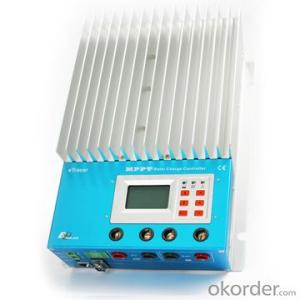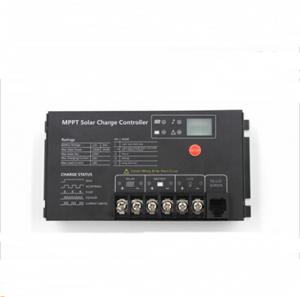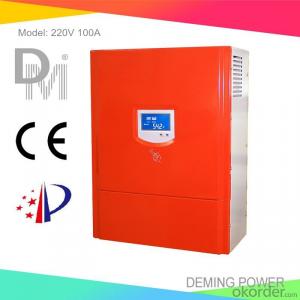MPPT Solar System Charge Controller 60A,12/24/36/48V,ET6415N
OKorder Service Pledge
OKorder Financial Service
You Might Also Like
Descriptions
This is an industrial grade product with advanced Maximum Power Point Tracking (MPPT) algorithm. It can deliver the maximum available power for charging batteries and charge a lower nominal voltage battery from a higher nominal voltage array. And can be applied in the off-grid PV systems up to 3KW. The die-cast aluminum design ensures excellent heat dispersion.
Specifications
MPPT charge controller
Maximum power point tracker
temperature compensation
LCD display
Communicate with PC
Features:
·12/24/36/48V auto work
·Advanced MPPT technology
·Several seconds tracking speed
·High Tracking efficiency of 99%
·Multiphase synchronous rectification technology
·Peak conversion efficiency of 98%
·DSP&ARM processors architecture ensures high speed and performance
·Gel, Sealed, Flooded battery option
·Max. 450 days data logging by connection to PC
·Multifunction LCD displays system data and status
·Three kinds of communication ports :RS232, CAN BUS and Ethernet
·Three stages charging optimizes battery performance
·Software update by users
Electronic Protections:
·PV short circuit protection
·PV reverse polarity protection
·PV overvoltage alarm protection
·PV over current protection
·Battery overcharge protection
·Battery over discharge protection
·Battery reverse polarity protection
·Overheating protection
Specification:
Model | ET3415N |
Rated system voltage | 12V/24V /36V/48V auto work |
Rated battery current | 30A |
Max. PV open circuit voltage | 150V |
Voltage range | 8~72V |
Max.PV input power | 400W (12V) 800W (24V) 1200W (36V) 1600W (48V) |
Self-consumption | 1.4~2.2W |
Grounding | Negative |
Dimension | 231x203x105mm |
Terminal | 35mm2 |
Net Weight | 4.1kg |
Working temperature | -25℃~+55℃ |
Storage temperature range | -30℃~+85℃ |
Humidity | 10%-90% NC |
Enclosure | IP20 |
Altitude | ≤3000m |
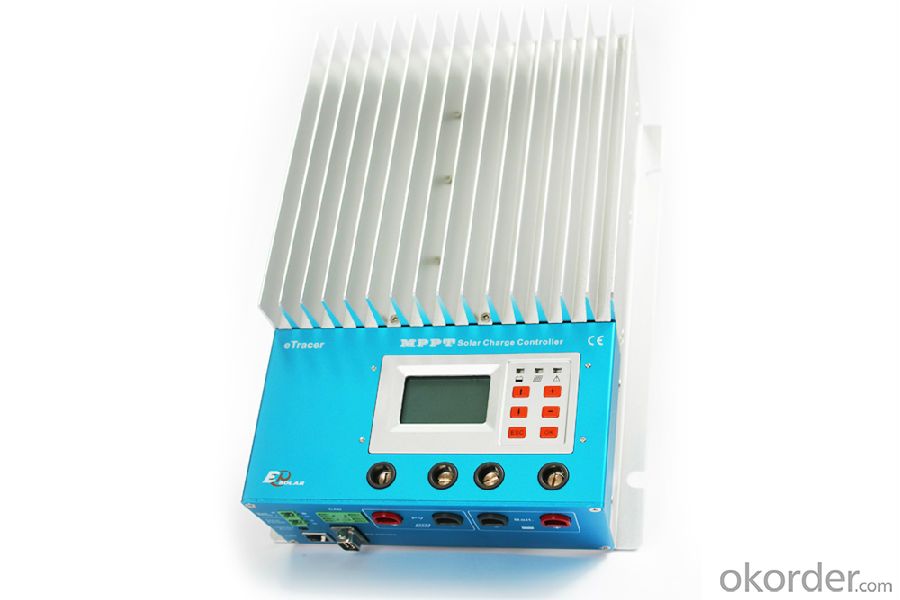

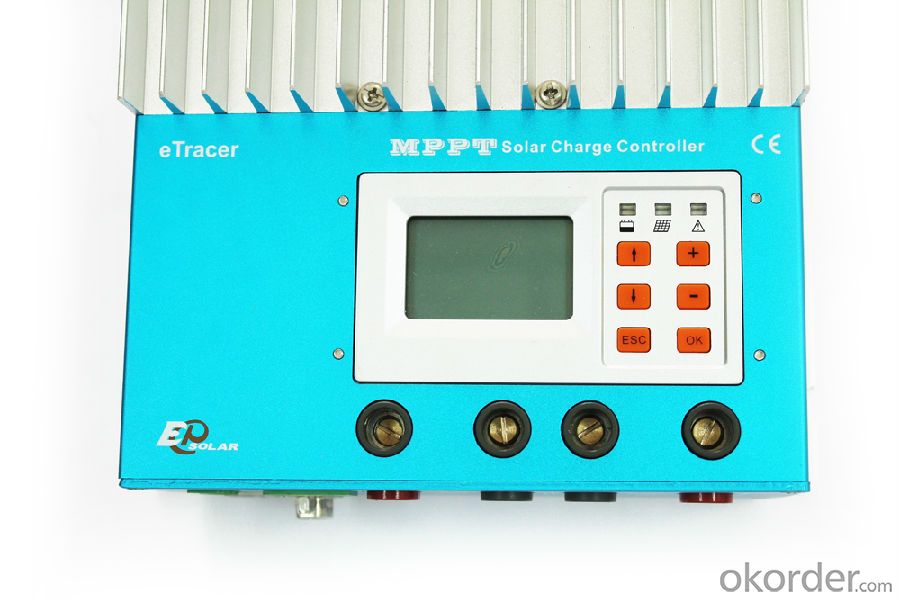
FAQ
1. What is included in the package?
1*MPPT Solar Charge Controller
1*User Manual
2. What does the battery red indicator LED mean?
Low voltage of battery
- Q:How do MPPT solar controllers work?
- MPPT solar controllers work by continuously monitoring and adjusting the voltage and current levels from the solar panels to maximize the power output. They use a technique called maximum power point tracking (MPPT) to find the optimal operating point where the panels produce the most power. By dynamically adjusting the input parameters, MPPT controllers ensure that the solar panels operate at their peak efficiency, resulting in higher energy harvest and improved overall performance of the solar system.
- Q:Can a solar controller be used with solar panels of different angles?
- Solar controllers can indeed be used with solar panels of varying angles. The primary function of a solar controller is to regulate the flow of electricity from the solar panels to the battery or grid. The controller's effectiveness is independent of the angle at which the solar panels are positioned. While the angle of the panels does affect the efficiency and output of the solar system, it does not hinder the compatibility or functionality of the solar controller. Consequently, regardless of the angle at which the solar panels are positioned, a solar controller can effectively manage the battery's charging and discharging or the flow of electricity to the grid.
- Q:Can a solar controller be used in a solar-powered greenhouse system?
- Yes, a solar controller can be used in a solar-powered greenhouse system. A solar controller helps regulate the flow of electricity from the solar panels to the batteries, ensuring efficient charging and preventing overcharging. It also helps monitor and manage the power output, ensuring optimal performance of the greenhouse system.
- Q:Can a solar controller be used with a solar-powered public transportation facility?
- Yes, a solar controller can be used with a solar-powered public transportation facility. A solar controller is a crucial component in regulating and optimizing the charging and discharging of batteries in a solar power system. It ensures that the solar panels are efficiently converting sunlight into electricity and that the batteries are being charged and discharged at the appropriate levels. In a solar-powered public transportation facility, a solar controller would help manage the energy flow from the solar panels to power the electric buses or trains, ensuring reliable and sustainable operation.
- Q:How does a solar controller handle the protection against battery reverse polarity?
- A solar controller handles the protection against battery reverse polarity by implementing a built-in mechanism that prevents the flow of current in the wrong direction. This is typically achieved through the use of diodes or MOSFETs that act as one-way valves, allowing only the correct flow of current from the solar panels to the battery. As a result, it safeguards the battery from potential damage caused by reverse polarity.
- Q:Can a solar controller be used with solar-powered data centers?
- Yes, a solar controller can be used with solar-powered data centers. A solar controller regulates the flow of electricity generated by solar panels, ensuring proper charging and discharging of batteries. In a solar-powered data center, the solar controller plays a crucial role in managing the power supply and maintaining the stability and reliability of the system. It helps optimize energy usage, monitor battery health, and protect the equipment from overcharging or excessive discharge.
- Q:How does a solar controller protect batteries from deep discharge?
- A solar controller protects batteries from deep discharge by monitoring the battery voltage and disconnecting the load when the voltage drops below a certain threshold. This prevents the batteries from being drained too much, which can lead to irreversible damage and reduced battery life.
- Q:How do you connect solar panels to a solar controller?
- To connect solar panels to a solar controller, you will need to first ensure that the solar panels are properly positioned to receive maximum sunlight. Then, you need to connect the positive and negative terminals of the solar panels to the corresponding terminals on the solar controller. This is typically done using wires and connectors provided with the solar panels and controller. It is important to follow the manufacturer's instructions and ensure that the connections are secure to ensure efficient and safe operation of the system.
- Q:How does a solar controller prevent damage from overvoltage of batteries?
- A solar controller prevents damage from overvoltage of batteries by monitoring and regulating the charging process. It controls the flow of electricity from the solar panels to the batteries, ensuring that the batteries are not overcharged. Once the batteries reach their optimal voltage, the controller limits the charging current or diverts excess energy to a different load to prevent overvoltage. This protective mechanism helps maintain the longevity and performance of the batteries, preventing potential damage.
- Q:What is the role of a load control function in a solar controller?
- The role of a load control function in a solar controller is to manage and regulate the power supply to the connected loads or appliances in a solar power system. It ensures that the loads receive the appropriate amount of power and prevents overloading or damaging the system. The load control function helps optimize energy usage and improve the overall efficiency and reliability of the solar controller.
1. Manufacturer Overview |
|
|---|---|
| Location | |
| Year Established | |
| Annual Output Value | |
| Main Markets | |
| Company Certifications | |
2. Manufacturer Certificates |
|
|---|---|
| a) Certification Name | |
| Range | |
| Reference | |
| Validity Period | |
3. Manufacturer Capability |
|
|---|---|
| a)Trade Capacity | |
| Nearest Port | |
| Export Percentage | |
| No.of Employees in Trade Department | |
| Language Spoken: | |
| b)Factory Information | |
| Factory Size: | |
| No. of Production Lines | |
| Contract Manufacturing | |
| Product Price Range | |
Send your message to us
MPPT Solar System Charge Controller 60A,12/24/36/48V,ET6415N
OKorder Service Pledge
OKorder Financial Service
Similar products
New products
Hot products
Hot Searches
Related keywords

